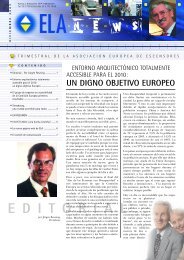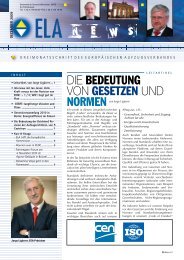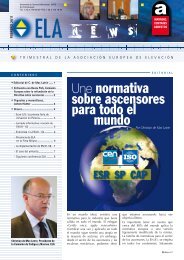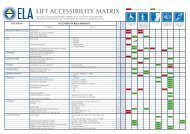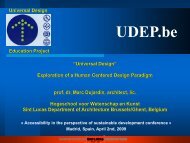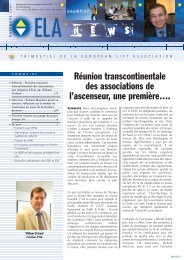WP6-Brochure-E4 brochure - ELA European Lift Association.
WP6-Brochure-E4 brochure - ELA European Lift Association.
WP6-Brochure-E4 brochure - ELA European Lift Association.
Create successful ePaper yourself
Turn your PDF publications into a flip-book with our unique Google optimized e-Paper software.
The scope of the present study is obviously limited and results give a simplified picture of the<br />
<strong>European</strong> lift and escalator market. The EU consists of 27 heterogeneous countries, in regard<br />
to size, population density, demographic structures, as well as economic development – these<br />
and other factors have strong implications for the lift and escalator market. Thus, for example,<br />
even if lack of capital was not identified as a major barrier to energy efficiency at a general<br />
level, it may be of high relevance in some regions of the EU.<br />
Making lifts and escalators more energy‐efficient is even more important in an international<br />
dimension: internationally, the population is growing and therefore cities are also growing<br />
extensively – thus the importance of vertical transportation is constantly rising, posing a<br />
constant challenge to energy efficiency.<br />
7.3 Guidelines for New <strong>Lift</strong> Installations and Retrofitting<br />
<strong>Lift</strong>s and escalators are individually engineered systems instead of off‐the‐shelf products or<br />
standardised products. Elevators in particular are very heterogeneous systems: they can be<br />
standard systems, more individualised systems based on standard components or, in special<br />
applications, individually tailored installations where individual components and equipment<br />
are used.<br />
This document provides advice on options to increase energy efficiency of new and existing<br />
installations. However, recommending standard measures is difficult, if not impossible, due to<br />
the large heterogeneity of installations and their usage. Thus, in order to increase energy<br />
efficiency, the system as a whole has to be evaluated, taking into account both the energy<br />
performance of single components and their interaction, as well as further conditions, starting<br />
with frequency of use. There are only few features that are advisable in general.<br />
Therefore, a list is provided, identifying features that are possibly helpful in reducing energy<br />
consumption. It has been compiled from the project findings, from discussions with experts<br />
and stakeholders (cf. [11]), and from relevant literature (e.g. Nipkow 2005 [12], Guideline<br />
VDI 4707 [6], Draft International Standard ISO/DIS 25745‐1[7], Clausnitzer et al. 2009 [13],<br />
Barney 2007 [14], Beier 2009 [15]). It is supposed to be used as a checklist for planning new<br />
installations or increasing the energy efficiency of existing installations. The checklist claims to<br />
be neither conclusive nor exhaustive, nor does it claim general energy efficiency or costeffectiveness<br />
of the measures.<br />
In the following, several lists with features that can possibly help increase energy efficiency are<br />
provided. These lists are either relevant for lifts, escalators or both systems. Each feature is<br />
briefly discussed and commented. Then a recommendation for an energy‐efficient solution is<br />
given, with an indication under which conditions this feature is especially relevant.<br />
7.3.1 Common features for energy‐efficient installations<br />
Energy efficiency of installations can be best obtained if energy efficiency is considered from<br />
the very beginning of the planning process (see also [16], pp. 60–63). Awareness and<br />
105





